Vascular Ehlers Danlos Syndrome and Chromosome 2q32 Microdeletion Syndrome
IF 4.6
2区 生物学
Q2 BIOCHEMISTRY & MOLECULAR BIOLOGY
引用次数: 0
Abstract
Interstitial deletions of 2q32 are typically identified after investigation for developmental delay. Two genes associated with Ehlers Danlos Syndrome (EDS); COL3A1 and COL5A2 associated with vascular EDS and classical EDS respectively, may be incorporated in the region. Although many reports of 2q32 microdeletion patients exist, there is little mention of these genes with only a few reports highlighting features potentially linked with EDS. This paper reviews the literature and presents eleven new patients with 2q32 deletions that encompass COL3A1 and COL5A2. We describe their clinical manifestations with a particular focus on the EDS phenotype. Most patients showed some minor features of vascular EDS and one patient had vessel rupture at a young age. Analysis of skin biopsy findings from two patients showed features consistent with vascular EDS but no features of classical EDS. The findings from this cohort provide additional evidence that haploinsufficiency is an important disease mechanism in COL3A1 but not COL5A2. We highlight the importance of pre-test counselling for incidental findings from broad genetic testing and appropriate post-test counselling to ensure follow up is provided to manage the implications of a vascular EDS diagnosis.

血管Ehlers Danlos综合征和染色体2q32微缺失综合征。
2q32的间质缺失通常是在研究发育迟缓后发现的。与Ehlers - Danlos综合征(EDS)相关的两个基因COL3A1和COL5A2分别与血管EDS和经典EDS相关,可能合并在该区域。尽管存在许多关于2q32微缺失患者的报道,但很少提及这些基因,只有少数报道强调了可能与EDS相关的特征。本文回顾了文献,并提出了11例新的2q32缺失患者,包括COL3A1和COL5A2。我们描述了他们的临床表现,特别关注EDS表型。大多数患者表现出血管性EDS的一些轻微特征,1例患者在年轻时发生血管破裂。分析两例患者的皮肤活检结果显示血管性EDS的特征,但没有典型EDS的特征。该队列的研究结果提供了额外的证据,证明单倍功能不全是COL3A1而不是COL5A2的重要疾病机制。我们强调从广泛的基因检测中偶然发现的检测前咨询和适当的检测后咨询的重要性,以确保提供随访,以管理血管EDS诊断的影响。
本文章由计算机程序翻译,如有差异,请以英文原文为准。
求助全文
约1分钟内获得全文
求助全文
来源期刊

European Journal of Human Genetics
生物-生化与分子生物学
CiteScore
9.90
自引率
5.80%
发文量
216
审稿时长
2 months
期刊介绍:
The European Journal of Human Genetics is the official journal of the European Society of Human Genetics, publishing high-quality, original research papers, short reports and reviews in the rapidly expanding field of human genetics and genomics. It covers molecular, clinical and cytogenetics, interfacing between advanced biomedical research and the clinician, and bridging the great diversity of facilities, resources and viewpoints in the genetics community.
Key areas include:
-Monogenic and multifactorial disorders
-Development and malformation
-Hereditary cancer
-Medical Genomics
-Gene mapping and functional studies
-Genotype-phenotype correlations
-Genetic variation and genome diversity
-Statistical and computational genetics
-Bioinformatics
-Advances in diagnostics
-Therapy and prevention
-Animal models
-Genetic services
-Community genetics
 求助内容:
求助内容: 应助结果提醒方式:
应助结果提醒方式:


